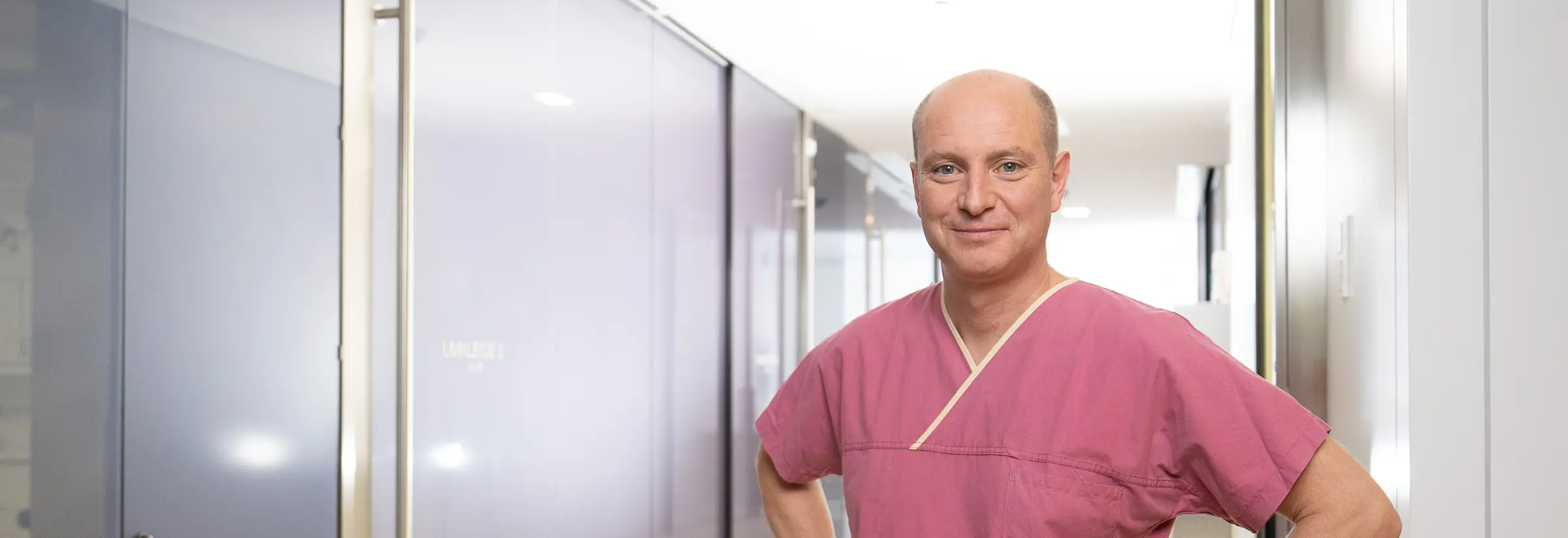
ORTHOPAEDICS
AMIS METHOD – MINIMALLY INVASIVE HIP REPLACEMENT SURGERY
The AMIS technique is a minimally invasive surgical method for implanting an artificial hip joint. AMIS stands for “anterior minimally invasive surgery”. This means that the surgeon uses the anterior approach (aka DAA = Direct Anterior Approach) to the hip joint.
The AMIS method is becoming increasingly popular in total hip arthroplasty. The advantages of this particularly gentle surgical method are obvious. While muscles have to be cut to reach the joint in traditional surgical methods, the muscles are simply pushed aside in the AMIS technique. This means that the tissue around the hip is significantly less affected by the AMIS technique.
Large muscles are located in the hip and pelvic area in particular. In the case of surgical injuries, these large muscles heal very slowly and with difficulty, and sometimes not at all. The AMIS technique aims to prevent such injuries, as the hip joint prosthesis is inserted through a natural gap between the muscles. There are also no nerves in the approach of the minimally invasive surgical method, meaning that the risk of permanent muscle, tendon or nerve damage as a result of the operation is significantly reduced.
The advantages of the AMIS method are obvious. The client loses less blood during hip joint arthroplasty. The intact muscles and tendons mean that the client is mobile again more quickly. The leg can be loaded immediately and complications such as joint dislocation rarely occur. Cosmetically, the small skin incision is of course also a plus point of the minimally invasive surgical technique.
The AMIS technique is mainly used for hip osteoarthritis, but also for other hip joint diseases such as femoral head necrosis.
Prof Dr Jörg Holstein is responsible for the operation, its planning and execution at the ETHIANUM Clinic in Heidelberg. He is one of the leading representatives of the AMIS technique. The experienced specialist in hip and knee endoprosthetics trains German and international colleagues in the AMIS technique as a surgical instructor and consultant.
Below we have discussed and answered the most frequently asked questions about the AMIS technique with Prof Dr Holstein. Find out more about this innovative surgical method.
AMIS METHOD
THE SPECIALIST AT THE ETHIANUM
Prof Dr Jörg Holstein is an expert in the application of the AMIS technique. Find out more about the orthopaedic specialist and his CV.

JÖRG HOLSTEIN
–
Specialist in orthopaedics and trauma surgery
Prof. Dr. Jörg Holstein is a specialist in orthopaedics and trauma surgery. He specialises in hip and knee endoprosthetics. His minimally invasive and muscle-sparing surgical techniques and his vision for the benefit of his clients make him particularly popular.
FAQ
QUESTIONS AND ANSWERS ON MINIMALLY INVASIVE AMIS HIP SURGERY
For which age group is the AMIS method suitable for hip replacement surgery?
In principle, the AMIS method can be used in all age groups and with any body constitution. However, the operation is more demanding for muscular men than for slim, petite women. This is because the muscles have to be kept aside during the operation. Even when replacing a loosened hip stem, the AMIS technique is my preferred surgical method. The only exception is when a very long, straight hip stem needs to be implanted. In this case, a different surgical approach is sometimes chosen because it is not always possible to insert long revision stems through a muscle gap. This is of course clarified with the client in advance.
Does the operation using the AMIS technique have to be performed under general anaesthetic?
The AMIS surgical method can be performed under both general and spinal anaesthesia. During spinal anaesthesia, the patient is awake, but the legs are anaesthetised so that there is no pain during the operation.
When can I get up again after the procedure?
In principle, you can get up again on the day of the operation if this method is used.
Does the operated leg have to be relieved after the operation?
The operated leg can be fully weight-beared immediately. For safety reasons, forearm crutches should be used for at least the first few days after the operation.
How long is the inpatient stay?
Normally, you can go home a few days after hip joint replacement using the AMIS method. Of course, this decision is made individually together with you as the patient, so that a shorter or longer stay in the clinic is also possible. Rooming-in is also an option at the ETHIANUM Heidelberg.
Is inpatient rehabilitation necessary after the operation?
Inpatient rehabilitation is possible after minimally invasive implantation of a hip joint endoprosthesis using the AMIS technique, but is not necessary. From a medical point of view, normal outpatient physiotherapy is completely sufficient. As the patient, you decide whether you prefer inpatient rehabilitation or outpatient physiotherapy, for example in our physiotherapy practice.
When can I drive again independently?
In principle, you can drive a car again very soon after your AMIS hip replacement. For insurance reasons, however, it is advisable to wait about four weeks after the procedure.
When can I return to work?
That depends very much on your profession. Desk jobs can be resumed very quickly, usually within the first few weeks after the operation. Occupations that involve heavy physical labour require a longer break. A few months should be expected in this case. The reason: if the endoprosthesis is anchored in the bone without cement, the implant must first “grow into the bone”. If the operated hip is exposed to extreme loads during this phase, the ingrowth of the artificial hip joint may be disturbed.
When is sport possible again?
Which sport is the question. Sports that involve movement of the joint without higher impact can be resumed shortly after the operation. Cycling, for example, is usually possible again just one week after the operation, but using the exercise bike first to be on the safe side.
As soon as the wound has healed after around two to three weeks, you can also go swimming again. Stop and go sports such as squash or volleyball are not ideal for the artificial – as well as for the natural – hip joint, as they can lead to faster wear and tear or earlier loosening of the endoprosthesis. In principle, however, almost all sports are possible again in the medium term.
How long does an artificial hip joint endoprosthesis last?
The implants used today have an average service life of around twenty years. However, the service life of a prosthesis depends on many factors.
In principle, the poorer the bone quality and the more extreme the daily load on the hip, the higher the risk of a prosthesis loosening or wearing out over time. Septic loosening must be distinguished from this so-called aseptic loosening of an endoprosthesis. Septic loosening of an endoprosthesis is caused by a bacterial infection. Bacteria can reach the artificial joint via the bloodstream as a result of a dental infection, for example. Accordingly, particular caution is required in the case of infections, for example of the teeth, but also in other parts of the body (throat, nose, ear infections, infected wounds, etc.). In such cases, a doctor should always be consulted and antibiotic therapy should be carried out to protect the endoprosthesis.
What are the symptoms of a hip joint endoprosthesis loosening?
Symptoms of a loosened hip joint endoprosthesis are pain, especially when exerting pressure, as well as an occasional feeling of instability in the hip. If the hip joint region is reddened, swollen and overheated or fever occurs, a bacterial infection may be present. In these cases, prompt diagnostics are essential to clarify the suspicion and cause of a loosening.
In the event of loosening without infection, the affected part of the prosthesis can be replaced in a single procedure. In many cases, this is also possible using the minimally invasive AMIS technique. If a bacterial infection is found to be the cause of the loosening of the endoprosthesis, more than one procedure is often necessary in addition to antibiotic therapy in order to first treat the infection and then implant the new endoprosthesis in the next step. Fortunately, however, septic endoprosthesis loosening occurs comparatively rarely.
Service
Video CONSULTATION
Questions and answers about AMIS technology
The AMIS – Technology FAQ No. 1
You are currently viewing a placeholder content from YouTube. To access the actual content, click the button below. Please note that doing so will share data with third-party providers.
More InformationThe AMIS – Technology FAQ No. 1
You are currently viewing a placeholder content from YouTube. To access the actual content, click the button below. Please note that doing so will share data with third-party providers.
More InformationThe AMIS – Technology FAQ No. 1
You are currently viewing a placeholder content from YouTube. To access the actual content, click the button below. Please note that doing so will share data with third-party providers.
More Information“The use of special instruments and a special operating table minimizes the risk of muscle or nerve injuries in the AMIS technique. Blood loss with the AMIS surgical technique is very low and the risk of joint dislocation is minimal. But the biggest advantage is that the client is fit again very quickly and can put weight on the leg immediately.”
Prof. Dr. Holstein

